Huashan Mountain
Huashan Mountain, also Mt. Hua, also known as Huashan Mountain, is located in Huayin County, 120 kilometers from Xian. Mt. Huashan is known as the most precipitous mountain under heaven and ranks as one of the five most famous mountains in China. Consisting of five perilous peaks, the mountain displays spectacular and fascinating landscapes allowing visitors inspirational and breathtaking experiences. The Xiyue Temple, the best temple of the 'five famous mountains' is 5 kilometers north of the Mt. Huashan. Xiyue Temple is also an essential part of the experience of Mt Huashan.
What to see ?
East Peak (Facing Sun Peak)
Climbing to the top of East Peak of Mt. Huashan takes 4 to 6 hours. It has an altitude of 2,090 meters, forming a platform for visitors to view the sunrise. An astronomical telescope is provided here. The reference time for sunrise is 5:00a.m.-6:00a.m. in spring, 4:30a.m.-5:20a.m. in summer, 5:00a.m.-5:20a.m. in autumn and 5:30a.m.-6:00a.m. in winter.One well-known scenic spot, the Immortal's Palm Peak, ranked as one of the Eight Scenic Wonders of the Xian, is located on the East Peak. It refers to the natural rock veins of the cliff, which look like a giant palm-print.
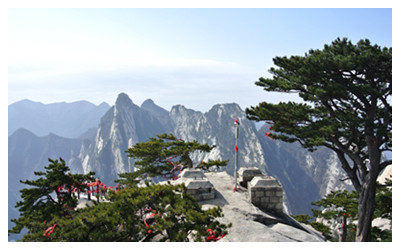
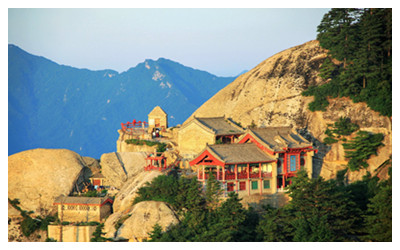
The legend goes that on March 3rd of the Lunar Calendar a torrential flood destroyed the villages within the Mt. Huashan area. This disaster was caused by the Queen Mother of the West, who held her Flat Peach Carnival celebration that year. She carelessly spilled a little jade wine down from paradise, causing a serious flood below. This news was quickly reported by Deity Shaohao to the Jade Emperor in Celestial Paradise. He gave a prompt order to Deity Juling to go down to tame the flood. When Deity Juling, full of vigor and vitality, descended from the clouds, he arrived at the precipitous cliff of East Peak. At the moment that he laid his left hand on one side and his right leg on the other, he ripped Mt. Huashan into two halves and immediately a flood rushed out. This tale adds luster to East Peak.
Travel Tips: After enjoying the sunrise at East peak, you can descend according to this route in case you have missed some scenic spots: East Peak – about 35 min to Heavenly South Gate – 5 min to Changkong Plank Road – 25 min to Heaven Watching Pool – 5 min to South Peak – 35 min to West Peak – 15 min to Middle Peak – 20 min back to Black Dragon Ridge – 25 min to Macaque Sorrow – 5 min to North Peak.
West Peak(Lotus Flower Peak)
West Peak has very high cliffs standing erect with an altitude of 2,086 meters. There is a Taoist temple called Cuiyun Palace, before which a huge rock looking like a lotus flower comes into view, hence the name Lotus Flower Peak. There are another seven rocks beside Cuiyun Palace, which is said to be the place where Chenxiang, a main character in the movie Lotus Lantern, ripped Mt. Huashan to save his mother, The Heavenly Goddess San Sheng Mu.
|
|
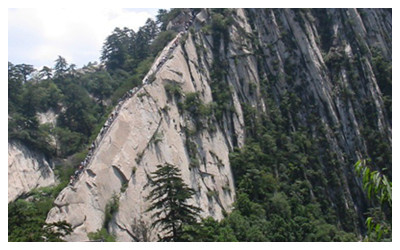 |
||
| Climbing Path to the West peak | Cable car to the West Peak |
South Peak (Landing Wild Geese Peak)
With an altitude of 2,160 meters, the South Peak is regarded as the monarch of Mt. Huashan because it is the highest peak and also the highest peak among the Five Sacred Mountains of China. Visitors who summit South Peak are undoubtedly winners. Looking around when standing at the peak, the surrounding landscapes are luxuriantly green; the Yellow River wanders far below and everything seems small. A legend goes that the wild geese returning from the south often landed at South Peak, giving the area the name Landing Wild Geese Peak.
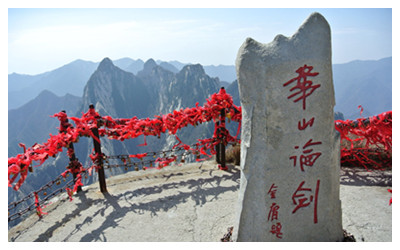 |
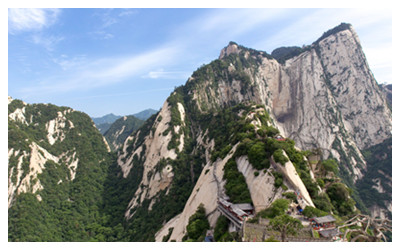 |
||
| South Peak | Middle Peak |
At the top of South Peak, the Black Dragon Pool at the summit and the Greeting Pines on the southwestern cliff are two attractive resorts. At each side of the Landing Wild Goose Peak there are two peaks, Songhui Peak (Pine and Juniper Peak) in the east and Xiaozi Peak (Filial Son Peak) in the west. The three peaks form a picture of a Titan sitting in a chair. The most dangerous place is Changkong Plank Road, a plank path built along the side of a vertical cliff, about 0.3 meters (1 foot) wide. Below is a bottomless gulf which makes visitors shake with fear. In addition, there is a Taoist temple called Baidi Temple or Jintian Palace, considered to be the host temple of Deity Shaohao.
North Peak (Cloud Terrace Peak)
There are precipitous cliffs on all sides of North Peak, making it look like a flat terrace in the clouds, hence the name Cloud Terrace Peak. It is 1,614 meters (5,295 feet) high. Three sides are cliffs and one side is to the Ear-Touching Cliff, which is the fourth precipitous path where visitors can climb up only by pressing an ear close to the cliff. Almost halfway up the North Peak trees are luxuriantly green, creating a good rest spot.
Upon arrival at the North Peak, you can walk to the Cableway Station in 3-5 min and take the cable car to descend.
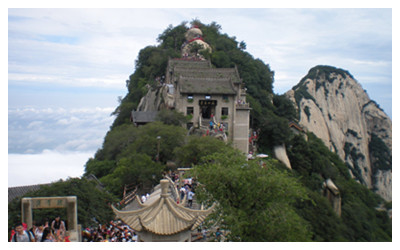

Middle Peak (Jade Maiden Peak)
Middle Peak clings to East Peak and is in the center of East, South and West Peaks. There is a Taoist temple on the peak named Jade Maiden Temple. Legend has it that the daughter of Qin Mugong (569 - 621 BC) loved a man who was good at playing Chinese tung-hsiao (vertical flute) and she gave up the royal life to become a hermit who cultivated her spirituality here, hence the name Jade Maiden Peak. Today Jade Maiden Temple and Jade Maiden Basin for Shampooing can be found on the peak. Other scenic spots in Middle Peak include Rootless Tree and Sacrificing Tree, which have beautiful stories and add to the supernatural atmosphere of Middle Peak.
Mt. Huashan is also home to several influential Taoist temples, where many emperors of past dynasties took part in Taoist activities and sacrificed to the god of mountain, making it a holy land of Taoism. At its foot, are the representatives of its Taoist elements.
Xiyue Temple: Located at the foot of Mt. Huashan, Xiyue Temple is 120 km east of Xian City. It was built to honor the god of the mountain during the reign of Emperor Wudi in the Western Han Dynasty (206 BC - 24 AD). Since then many emperors have made sacrifice here to the god of the mountain.
Xiyue Temple is referred to as the Forbidden City of Shaanxi because of its constructions and the overall composition. Facing towards Mt. Huashan, it is a must-see place as visitors start or finish climbing the mountain. The main buildings here are Haoling Gate, Five-Phoenix Pavilion, Lingxing Gate, Golden City Gate, Haoling Palace, Study of Emperors, and Long Live Pavilion.
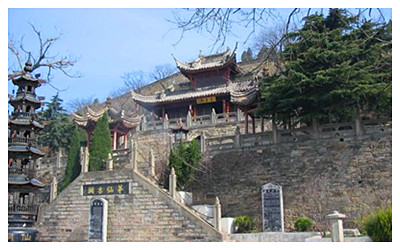 |
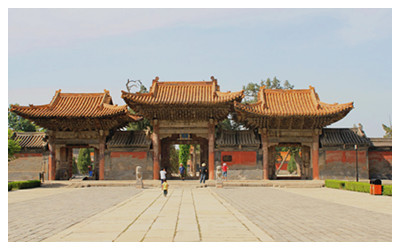 |
||
| Yuquan Temple ( Jade Spring Temple) | Xiyue Temple |
Jade Spring Temple: It is a must-pass place when visiting Mt. Huashan. People consider Jade Spring Temple as the door to the mountain. Belonging to a Taoist Temple, it functions to hold Taoist practices and activities. It was originally built during the reign of Emperor Shenzong in the Northern Song Dynasty (960 - 1127) to honor Chen Tuan (871 - 989), a famous scholar and eremite of the Quanzhen School (a branch of Taoism), by Jia Desheng, a student of Chen. Chen Tuan once was named Mr. Xiyi by an emperor, so people call him “Taoism Father Chen Tuan”, “Sleeping Fairy” or “Taoism Father Xiyi”. He combined the ideology of Quietism, Taoism, Confucianism and Buddhism making great contributions to the development of neo-Confucianism, a Confucian School of ideal philosophy in the Song Dynasties (960 - 1279).
The temple is surrounded by a long corridor. The Long Corridor of Seventy-two Windows is a feature here which is unique among all the temple constructions. It is delicately designed according to the seventy-two phenological phenomena recorded in the Chinese annals. The windows are of round and square shapes. The 72 patterns on the windows are flowers and plants, insects and fish etc.
How to travel ?
Visitors need to know Mt.Huashan:
1. Dangerous Passes in Huashan Mountain
Along the way to East Peak of Mount Huashan you should be very careful when passing the major dangerous passes, such as the above-mentioned Thousand-Foot Precipice, Hundred-Foot Crevice, Black Dragon Ridge and Golden Lock Pass.
2. Climbing Route in Huashan Mountain
Hike on Huashan Mountain is very popular among visitors. For many years most people have taken a traditional but efficient walking-ascending and cable-car-descending route for this mountain climbing. By taking this route, visitors can experience not only its danger, but also the major meaningful scenic spots. At the foot of Mt. Huashan, you can start your trip by visiting the Jade Spring Temple. After that, you can walk to the Memorial Archway in about 15 min, and then in 5 min you will get to Five Dragon Bridge, next to which is the ticket office.
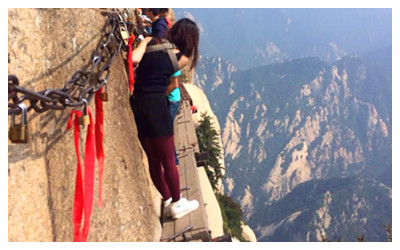
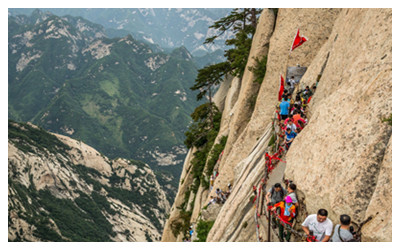
Passing through the ticket office of Mt. Huashan, you will see the scenic spots one by one:
walking about 30 min to Fish Stone – 20 min to Five-Mile Pass – 15 min to Stone Gate - 10 min to Shaluo Terrace – 10 min to Maonv Cave – 10 min to Qingke Terrace – 10 min to Mind Changing Stone (Huixin Stone) – 10 min to Thousand-Foot Precipice – 15 min to Hundred-Foot Crevice – 15 min to Taoist Temple of A Group of Immortals – 15 min to Laojun Furrow – 10 min to Ear-Touching Cliff – 5 min to Heavenward Ladder – 5 min to Black Dragon Ridge – 25 min to Golden Lock Pass – 10 min to Five-Cloud Peak – 15 min to Sunshine Welcoming Cave – 5 min to East Peak.
3. Easily travel by Mt.Hushan Cable car
Visiting Huashan Mountain by cable car is another good choice for visitors. On the east side of Yuquan Temple, there is an about 8 kilometer long concrete road leading up to Wamiaogou where you can take a cable car directly to the North Peak of Mt. Huashan. The top station is located on the east cliff of North Peak. The whole ride is more than 1,500 meters long and takes seven or eight minutes. The other cable car line starts from Donggoukou to West Peak with a stop at White Sparrow Temple. The whole ride is about 4,211 meters long and takes about 20 minutes. It is easier to get to the South and East Peak from West Peak compared with the North Peak.
Mt.Huashan Cable Car Service
| Service Hours | Mar. - Nov.: 07:00-19:00 Dec. - Feb.: 08:00 - 18:00 |
|---|---|
| Donggoukou - White Sparrow Temple - West Peak | Mar. - Nov.: CNY 280 for a round trip; CNY 140 for a one-way trip Dec. - Feb.: CNY 240 for a round trip; CNY 120 for a one-way trip Notice: 1) Wengyu Tourism Bus runs between Tourist Service Center and Donggoukou, the lower station of West Peak cable car. It costs CNY 40 for a one-way trip and CNY 80 for a round trip. 2) Visitors can get off at White Sparrow Temple. After visiting the temple, continue to take the cable car to the West Peak. |
| Wamiaogou - North Peak | Mar. - Nov.: CNY 150 for a round trip; CNY 80 for a one-way trip Dec. - Feb.: CNY 80 for a round trip; CNY 45 for a one-way trip Notice: Huangfuyu Tourism Bus runs between Tourist Service Center and Wamiaogou, the lower station of North Peak cable car. It costs CNY 20 for a one-way trip and CNY 40 for a round trip. |
Travel Tips
| Entrance Fee | Mar. - Nov.: CNY 180; Dec. - Feb.: CNY 100 Note: 1. It includes the main peaks scenic area, Jade Spring Temple, Xianyu Scenic Area and Xiyue Temple. 2. The ticket is valid for two days. |
|---|---|
| Opening Hours | The mountain is open all day. Xiyue Temple: 09:00 - 17:30 Jade Spring Temple: 09:00 - 19:00 |
| Best Time to Visit | April to October |







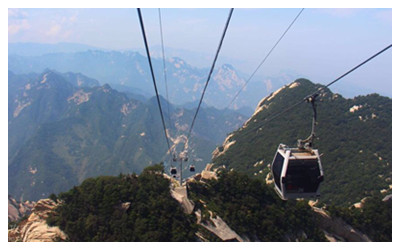
 Ask Questions ?
Ask Questions ?